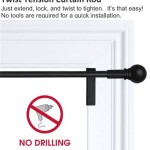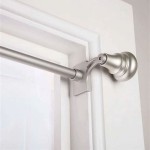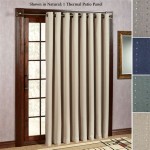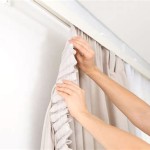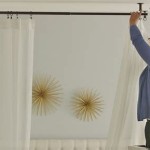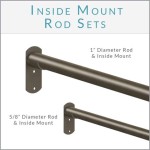Curtain Rod Holders Without Drilling: A Comprehensive Guide
Hanging curtains is a common home decor task, but the prospect of drilling holes in walls can be daunting for renters, those concerned about damaging surfaces, or individuals simply seeking a less permanent solution. Fortunately, advancements in adhesive technology and innovative designs have led to the development of curtain rod holders that require no drilling. This article delves into the various types of drill-free curtain rod holders, their advantages and disadvantages, installation techniques, weight capacities, and considerations for specific window types. Proper selection and installation are crucial for ensuring the stability and functionality of these systems.
Types of Drill-Free Curtain Rod Holders
Several types of drill-free curtain rod holders are available, each utilizing different mechanisms for adhesion and support. Understanding these options is essential for choosing the most suitable solution for a given situation.
Tension Rods: Tension rods are perhaps the oldest and most well-known drill-free option. These rods utilize internal springs or telescoping mechanisms to create pressure against the window frame or inside the recess of a doorway. The tension generated holds the rod in place, supporting the weight of the curtains. Tension rods are best suited for lightweight curtains and narrower windows or doorways, as their weight capacity is limited by the strength of the tension mechanism and the structural integrity of the surfaces they are pressed against.
Adhesive-Backed Brackets: These brackets utilize strong adhesive pads to adhere directly to the wall or window frame. The adhesive is typically a double-sided tape or a specialized glue that creates a strong bond with the surface. The brackets themselves are designed to hold standard curtain rods. Adhesive-backed brackets offer a cleaner look than tension rods and can often support slightly heavier curtains, depending on the quality of the adhesive and the design of the bracket. However, proper surface preparation is critical for ensuring a strong and lasting bond. Rough, dirty, or uneven surfaces can significantly reduce the adhesive's effectiveness.
Leverage-Based Brackets: These brackets employ a system of levers and counterweights to distribute the weight of the curtains and rod, attaching to the window frame without the need for drilling or adhesive. They often utilize a combination of clamping and gripping mechanisms to secure themselves to the frame. Leverage-based brackets offer a more robust solution for heavier curtains and can be particularly useful for rental properties where minimizing damage is paramount. However, they may be more visible and less aesthetically pleasing than other options.
Magnetic Rods: Designed specifically for metal doors and surfaces, magnetic rods utilize powerful magnets to adhere to the surface. These rods are ideal for hanging curtains on steel doors, such as those found in some entryways or storage areas. The weight capacity of magnetic rods is determined by the strength of the magnets used, but they are generally suitable for lightweight to medium-weight curtains. Surface preparation involves cleaning the metal surface to ensure optimal magnetic contact.
Installation Techniques and Surface Preparation
Regardless of the chosen type of drill-free curtain rod holder, proper installation is crucial for ensuring stability and preventing failure. Surface preparation is particularly important for adhesive-backed brackets and magnetic rods.
Surface Cleaning: Before applying any adhesive or magnetic mounts, thoroughly clean the surface with a suitable cleaner, such as isopropyl alcohol. This removes dirt, grease, and other contaminants that can interfere with the adhesion process. Ensure the surface is completely dry before proceeding.
Surface Assessment: Evaluate the surface for any imperfections, such as peeling paint, loose wallpaper, or uneven textures. These imperfections can compromise the bond and should be addressed before installation. For example, loose paint should be scraped away, and uneven surfaces may require sanding or filling.
Adhesive Application: Follow the manufacturer's instructions carefully when applying adhesive-backed brackets. Typically, this involves removing the protective backing from the adhesive pad and pressing the bracket firmly against the cleaned surface for a specified duration. Allow the adhesive to cure for the recommended time period before hanging the curtain rod and curtains. This curing time allows the adhesive to fully bond with the surface, maximizing its strength.
Tension Rod Adjustment: When installing tension rods, ensure the rod is level and evenly distributed within the window frame or doorway. Over-tightening can damage the frame, while under-tightening can lead to slippage. Test the stability of the rod by gently pulling on it before hanging the curtains.
Leverage-Based Bracket Installation: Follow the manufacturer's instructions meticulously when installing leverage-based brackets. These brackets often require precise adjustments to ensure proper weight distribution and secure attachment to the window frame. Ensure all clamps and screws are tightened appropriately.
Magnetic Rod Placement: Ensure the metal surface is clear of any rust or corrosion, as these can reduce the magnetic attraction. Center the rod evenly on the surface and test its stability before hanging the curtains.
Weight Capacity and Curtain Selection
The weight capacity of drill-free curtain rod holders is a critical consideration. Overloading the holders can lead to failure, resulting in damage to the curtains, the window frame, or the surrounding area. It is essential to select curtains that are appropriate for the chosen holder type and to distribute the weight evenly along the rod.
Lightweight Curtains: Lightweight curtains, such as sheer panels or voile curtains, are suitable for tension rods, adhesive-backed brackets, and magnetic rods with lower weight capacities. These curtains typically weigh less than a pound per panel and are less likely to strain the holders.
Medium-Weight Curtains: Medium-weight curtains, such as cotton or linen blends, may be suitable for stronger adhesive-backed brackets, leverage-based brackets, and magnetic rods with higher weight capacities. Check the manufacturer's specifications for the maximum weight the holders can support. Consider using multiple brackets for wider windows to distribute the weight more evenly.
Heavyweight Curtains: Heavyweight curtains, such as blackout curtains or lined drapes, are generally not recommended for drill-free options, unless using leverage-based brackets specifically designed for heavier loads. The weight of these curtains can easily exceed the capacity of most adhesive-backed brackets and tension rods, leading to failure. If heavyweight curtains are desired, consider reinforcing the drill-free holders with additional support or opting for traditional drilled installation methods.
Weight Distribution: Even weight distribution is crucial for maximizing the lifespan and effectiveness of drill-free curtain rod holders. Avoid concentrating the weight of the curtains in one area of the rod. Use multiple curtain rings or hooks to distribute the weight evenly across the entire length of the rod.
Rod Material: The material of the curtain rod itself also plays a role in the overall weight capacity. Lightweight aluminum or plastic rods are suitable for lighter curtains, while heavier steel or iron rods can support slightly heavier loads, provided the holders are rated accordingly.
Testing and Monitoring: After installing the curtain rod and curtains, test the stability of the system by gently pulling on the rod. Monitor the holders regularly for any signs of loosening or sagging. If any issues are detected, reinforce the holders or replace them with a more robust option.
Considerations for Specific Window Types
The type of window being used can influence the choice of drill-free curtain rod holder. Different window frames have varying materials and structural properties, which can affect the adhesion and stability of the holders.
Wood Frames: Wood frames are generally well-suited for adhesive-backed brackets and leverage-based brackets, as they provide a solid and stable surface for adhesion and clamping. Ensure the wood is clean and free of any loose paint or varnish before installation. Tension rods can also be used effectively in wood-framed windows.
Metal Frames: Metal frames are ideal for magnetic rods, but they can also be used with adhesive-backed brackets, provided the surface is properly cleaned and prepared. Ensure the metal is free of rust or corrosion before applying the adhesive. Tension rods can also be used in metal-framed windows, but care should be taken to avoid scratching or damaging the metal surface.
Vinyl Frames: Vinyl frames can be challenging for adhesive-backed brackets, as the smooth surface can sometimes inhibit adhesion. Special adhesives designed for vinyl may be required. Leverage-based brackets can be a good option for vinyl frames, as they do not rely on adhesion. Tension rods can also be used, but care should be taken to avoid damaging the vinyl frame.
Drywall: While drywall is not a window frame material, it's often the surrounding wall. Adhesive-backed brackets applied directly to drywall are generally not recommended as the drywall paper may peel when the adhesive is removed or fails. If the curtain rod needs to extend beyond the window frame and attach to the drywall, consider using a traditional drilled installation with appropriate drywall anchors for better support.
Window Recess Depth: The depth of the window recess can affect the suitability of tension rods and leverage-based brackets. Ensure the recess is deep enough to accommodate the rods or brackets without interfering with the window operation or causing damage to the frame.
Careful consideration of these factors will ensure the selected drill-free curtain rod holders are appropriate for the specific window type and will provide adequate support for the chosen curtains.

No Drill Curtain Rod Brackets Kwik Hang

Hang Curtains Without Drilling Over Vertical Blinds No Drill The Nono Bracket

5 Easy Ways To Hang Curtains Without Drilling

5 Easy Ways To Hang Curtains Without Drilling

No Drill Curtain Rod Brackets Kwik Hang

Inside Mount Blinds Curtain Rod Bracket Attachment Hang Curtains Without Drilling The Nono

6 Pcs No Drill Curtain Rod Brackets Upgraded Drilling Self Adhesive Holder Universal Nail Free Adjustable Rods Hooks For

4pcs No Drill Curtain Rod Brackets Zinc Alloy Holder With Screw For Walls Silver

8 Pcs Curtains Extendable Bars Rod Holder Without Drilling Frame Metal White

2 6pc Curtain Pole Brackets No Drill Rod Holder Into Wooden Window Frame


